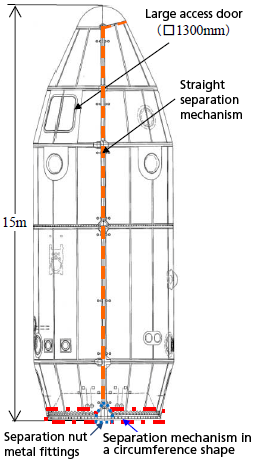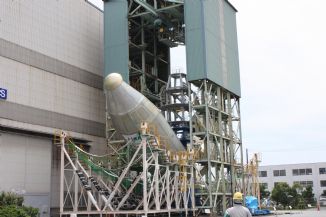Roles of H-IIB Launch Vehicle
The H-IIB Launch Vehicle is Japan’s large-scale rocket whose launch capability is at the highest level in the world. It was successfully developed in a short period by making the best use of technologies acquired through the experience of the H-IIA Launch Vehicle to realize a low-cost and low-risk launch vehicle. The H-IIB Launch Vehicle No. 2 (H-IIB F2) is scheduled to be launched on January 20 (Thu.,) 2011 to inject its payload, the second H-II Transfer Vehicle (HTV2) into its orbit.The H-IIB Test Flight was launched exactly at the scheduled launch time and date on September 11, 2009, and that was the first punctual launch of the first flight of Japan’s major launch vehicles. The H-IIB TF then successfully injected the HTV1 (technological demonstration flight) in its planned orbit. The H-IIB/HTV launch won praise throughout the world including from NASA, and was highly evaluated for its international contribution. As the H-IIB/HTV launch will be the only means for large-size cargo transportation to the International Space Station after the scheduled retirement of the Space Shuttle, the H-IIB F2 will be launched with the high expectations of the world.
H-IIB Configuration

Improvement of 5S-H fairing
 Fairing development for the H-IIB Test Flight
Fairing development for the H-IIB Test FlightIn order to cope with the launch of an HTV, which is the largest payload both in size and mass in Japan’s space development history, the fairing for the HTV was developed by expanding the biggest type of fairing for the H-IIA, 5S type, by three meters. The new fairing is a 5S-H type fairing with a total length of 15 meters.
In the development process of the 5S-H fairing, we conducted a test for durability (a qualification test) using exactly the same structure as a real one, and part of the separation mechanism at the bottom section of the fairing in a circumference shape was damaged, as was a metal part (nuts) and a joint part (bolts).
To deal with the above problem, we took some measures such as strengthening the surrounding areas of the damaged part, and installing pins to control slippage of the separation plane.
Then we tested the renovated fairing for its durability to verify that the measures taken were appropriate.
By overcoming such trouble, we successfully achieved the mission of the HTV1 by the H-IIB TF on schedule to inject it into its planned orbit.
Further improvement for the H-IIB F2
Based on the result evaluation of the above durability test as well as the actual fairing jettison data acquired from the launch of the Test Flight, JAXA has been working on further renovation of the fairing.
To have more margin in the separation mechanism, we began studying design modification of the said part (configuration change of the separation bolts and optimization of separation mechanism structure,) and we are now reverifying its appropriateness through durability and separation tests on a life-size test fairing.

